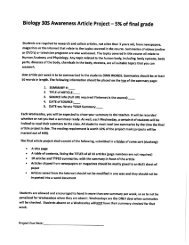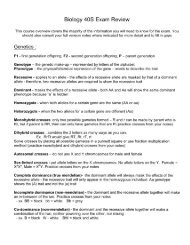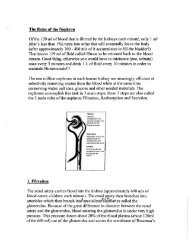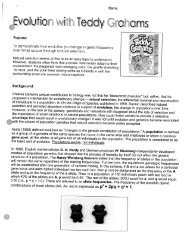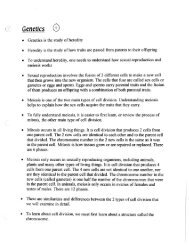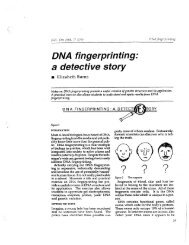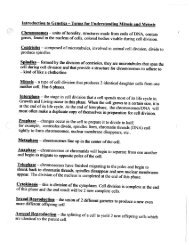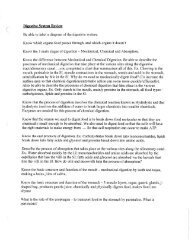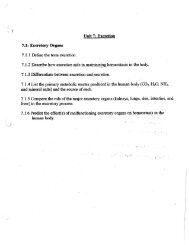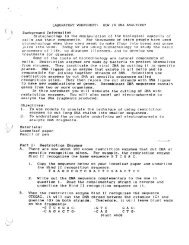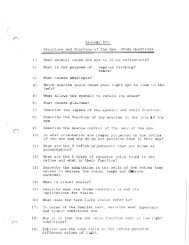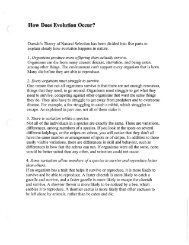Biology 30S - Mrs Stovel
Biology 30S - Mrs Stovel
Biology 30S - Mrs Stovel
- No tags were found...
You also want an ePaper? Increase the reach of your titles
YUMPU automatically turns print PDFs into web optimized ePapers that Google loves.
Example Feedback Loop(Temperature Regulation in the home)• Temperature set to be maintained at 20C inside• It is winter and cold outside• A device with a sensor called a Thermostat isset for 20C. it has the ability to detecttemperature and the ability to direct changesin the furnace in order to keep the inside temp.at20CInside Temp. Falls below 20C
Sccit, fbccSmCMnv112Homeostasisoperation of contractile vacuole inParamecium1. The contractile vacuole is full of water.Y^:YM-. iiifeifv!• ^v'»-,^'1:^^'J2. The contractile vacuole begins to expelexcess water.i^,-,--.:V.,\,One of the important characteristics of living things is that they canrespond to changes in the environment. The increased breathing rateof a mountain climber is an example of an organism's response tochanges In its surroundings. The ability of an organism to maintain astable internal environment when outside conditions change is calledhomeostasis (ho/me a sta^sis). Cells as well as organisms have thisability. The pictures to the left show an example of homeostasis inParamecium. When too much water enters a Paramecium, its contractilevacuole expels the excess water from the cell. Thus, the internalwater balance of the organism is maintained.A change in one cell function often affects what happens somewhereelse in the cell. For example, a damaged cell requires suchchemical building blocks as oxygen and glucose for repair. Therefore,the rate at which these materials enter the cell will increase. In addition,more chemicals and a faster rate of energy production causemore waste products to form in the cell. Since a buildup of wastescould damage or kill the cell, the rate of excretion must also increase.The description of what happens when a cell is damaged is anexample of a feedback mechanism. Changing one part of a systembrings about changes in other parts of the same system. Feedbackmechanisms help the cell respond to both internal and external changes.Greater demands for energy or new body parts, an excess or lackof food, outside stimuli—all cause the cell to change the rate at whichit carries out various functions. And the cell makes these changes insuch a way that its internal workings are not disrupted. The internalstability of living things, or homeostasis, is made possible by feedbackmechanisms.^ti/o^teU^^Q^.^.v-T3. Now nearly ennpty, the contractile vacuolecan collect more water from thecytoplasm.Did You Know?Your bodi^'s temperature is anotherexample of homeostasis. Your bodi;keeps \;our temperature at an almostconstant 37°C no matter what thetemperature of ];our outsideenvironment.^^sfyyINCREASE^£e ^^^ASE^SjisrsitKSS'MAINTAIN
HomTOStesis- iackoround InformationIntroductionAt any given time our body is working to maintain its intemal physiological environmentin a stable state, or a constant intemal balance. The example that comes readily to mostpeople's minds is our relatively constant body temperature. Think about the adjustmentsyour body must make to maintain this constant body temperature during an everydayactivity such as walking to school on a brisk winter moming in Manitoba.A Cold WalkBefore leaving the house you put on your winter outerwear - boots, mitts,hat, scarf and parka. The increased amount of clothing traps body heatand you begin to sweat as your body tries to cool down. As you leave thehouse and enter the cold winter air your exposed cheeks feel cold. Nearthe end ofthe walk you notice your toes and fingers beginning to feelnumb. You're late so you run the rest of the way to school. When youarrive you're glad to find the run has warmed up your fingers and toes,however, as you walk through the hallway to your locker you find yourselfbeginning to sweat agam. You remove your wmter outer wear at yourlocker and head to class. A few minutes later you find yourself becomingcold and you begin to shiver as your body tries to warm up.This example shows how your body works to maintam one specific aspect of its intemalenvironment - a body temperature of approximately 37 degrees Celsius. In fact, if yourbody fluctuates too much fi-omthis temperature, it could lead to death. Homeostasis isthe ability ofthe body to maintain its intemal environment within acceptable rangesdespite the changing external environment.In addition to a body temperature of about 37 degrees Celsius, you may be familiar withsome other body constants. These include a blood pressure of about 160/106 Kpa, ablood pH near 7.4, blood glucose concentrations at about lOOmg/mL. While these"normals" do vary, there is a very limited range within which the body can fijnction anddeath can result if these normal ranges are exceeded.In order to fimction properly, homeostatic mechanisms must allow the body to:regulate respiratory gasesmaintain water and salt balanceregulate energy and nutrient supplymaintain constant body temperatureprotect against pathogensmake repairs when injured
Homeostasis depends on the action and interaction of a number of body systems tomaintain a range of conditions within which the body can best operate. Because theextemal environment is constantly changing and homeostatic reactions respond to thechange and bring the body back to a given set point, it is often referred to as a dynamicequilibrium. A dynamic equilibrium is a condition that remains stable within fluctuatinglimits. Many homeostatic reactions begin with the body's sensing of changes in theextemal environment.Negative F^dback MechaniimiNegative feedback systems are an important mechanism used to maintain homeostasis, ordynamic equilibrium. There are many examples of negative feedback systems around us.In your home you set the thermostat to the "normal" temperature you would like yourhouse to stay at. If the temperature drops below this temperature a sensor notes thischange and causes the fiimace to come back on until the house has heated up to the settemperature. A negative feedback mechanism in your body also makes adjustments tobring things back to within an acceptable range.Feedback mechanisms have three main components: a sensor, and coordinating centreand an effector. The sensor is responsible for detecting variation in the set point and willsend messages to the coordinating centre that will then send a message to a specificeffector to rectify any variation from a set point.Temperature set to 20° C (NORMAL CONDITION)Intemal house temperature drops to 17° C (CHANGEThermostat detects drop in temperature (SENSOR)Thermostat turns on fiimace (COORDINATING CENTRE)Furnace starts and begins to warm house (EFFECTOR)Temperature returns to 20° C (NORMAL CONDITION)The coordination and regulation of homeostasis through negative feedback mechanism inthe body is most often achieved by a combination of nervous and hormonal mechanisms.HomeiMtatic SystemsThree important homeostatic systems in the human body that depend upon negativefeedback mechanisms to maintain equilibrium are: thermoregulation (the maintenance ofbody temperature), osmoregulation (water balance) and waste management.Thermor^ulation is the ability to maintain a constant body temperature. The constantbody temperature for humans is 37 degrees Celsius, although there are individualvariations. Humans are able to maintain a constant body temperature despite changes inthe extemal environmental temperature (endotherm). Tlie hypothalamus, a part ofthehuman brain, is the coordinating centre for body's temperature regulation. When there isa change in the extemal temperature the hypothalamus will release hormones that targetspecific effectors such as sweat glands.
( Oimoreguktion is the ability to maintain a constant water balance. For the body to/ maintain water balance, humans must consume fluidsdaily. A drop in fluidintake by aslittle as 1 % of your body mass will cause thirst, a decrease of 5 % will result in extremepain and collapse, while a decrease of 10 % often results in death. The hypothalamus isthe coordinating centre for water balance and can detect changes in the fluidconcentrations ofthe blood. When the fluidconcentration ofthe blood decreases(dehydration) then the hypothalamus will trigger the release of a hormone to increasewater absorption.Waste management, or the ability ofthe body to riditself of harmfiil wastes, is essentialfor the maintenance of homeostasis. One example of a harmfiil waste product is theammonia produced during the breakdown of proteins. Ammonia is extremely toxic to thebody. The liver is most important organ involved in the elimination of ammonia. Variousorgans, such as the kidneys, lungs, skin and stomach, as well as the liver, are involved inthe elimination of various other waste products.Hmi4€^k AesffOKi^t1. Define Homeostasis - in YOUR OWN WORDS (see your notes on theCharacteristics of Life and look up the term in the textbook glossary page 782).(1 mark)2. Read all handouts on Homeostasis as well as your text, pages 228 and 290.3. Construct a paragraph using all 13 words on tiie w0f^€/fiMk.DO NOT FLAGERIZE. All words must be used in proper context. Words may beused more than once and may be used in a different tense (for example, the word"increase" could be changed to "increased" or "increases"). Underline each ofthe13 words from the wordsplash just ONCE.(13 marks)
The Swimming Rapf65 kg Debra was sitting quietly along the side of the pool. She was anticipatingthe swimming race that she would be competing In shortly. Four-hundredmetres of Intense physical activity, pushing her body to the very limits of itscapabilities. She was calm and relaxed, mentally willing her heart and respiratoryrate down. She had done some stretching and warm-up exercises, but her heartrate was just 65 beats per minute and she was breathing 12 breaths per minuteHer body temperature was 37« C. She was well hydrated.That was an hour ago. Now, she was standing on the lane four starting blockready to go. She could see two swimmers to her left and three to her right. Theswimmers all looked bigger than her, but then they always did. The starter onthe pool deck was saying something over the loudspeaker but Debra wasn'tpaying attention. These last few seconds before the race were the moststressful-you could feel the tension in the air. She was sweating although the airwas cool. Her heart rate was now 85 beats per minute and she was breathing 18breaths per minute. She felt a nervous excitement.n"ake your mark," the starter announced and with the sound of the hom theswimmers dove into the water.After a short glide through the water Debra surfaced stroking at maximumpower. She was putting ail of her strength into each stroke.Thirty seconds later, she had traveled just over 50 meters. Debra wascompletely focussed shutting out the extemal extractions and concentrating onkeeping the power up. She was giving each stroke about 80% of her maximumpower. Her heart rate was 201. Her respiratory rate was also up sllghtiv Herbody temperature was 37.5" C. r » f.At the end of that first minute, Debra's heart rate was 180 beats per minute Shewas taking breaths every 6 strokes, fast and forced. Her body temperature wasWith 100 meters to go to the finish line, Debra had been swimming for just over3 minutes. Debra could see she was even with the swimmer In lane 2. Debraknew she needed to push herself if she wanted to win. She focused completelyon the placement and pull of each stroke. She was breathing faster, one breathevery 3 strokes. Her heart rate was 195 beats per minute and her bodvtemperature was 38.5" C.The winner of this race was going to be whoever touched the wall first As Debratouched the edge of the pool, four minutes and 15 seconds after starting andone-tenth of a second behind the swimmer from lane two, her heart rate was208 beats per minute. She slumped over the lane marker, breathing nearly 60times per minute but still not feeling like she could get enough air. It felt like heramis and legs were on fire. She felt light-headed. Her body temperature was 39"Ten minutes later after a cool down, Debra's heart rate and respiratory rate werealmost back to normal. She weighed 64 kgs. Her body temperature was still halfa degree above normal. She felt drained of energy. She was thirsty. She hadallowed herself only small sips of water during the cool down.
The f luifiifiiifif RoeeDescribe what is going on in Debra's body at each of the 7 times by filling in the chart.TimeMental State/FeelingsRespiratoryRateHeartRateHydrationStateBodyTemperatureBefore raceStarting block0-30 sec30 - 60 sec3 minAt finishAfter cool downDid Debra win the race?Did her body maintain homeostasis? How do you know?
Wellness CiieckupWellness is more than not being ill. Wellness is having a healthy body, mind and spirit.Are you monitoring your wellness?Do so by completing this checklist. Put a checkmark when the statement applies to you.General Information. I am aware of diseases that ran in my familyI know what type of illnesses I have hadI can explain the types of diagnostic test I have hadI know what type of treatment I have hadI know the story of my birth1 spend time with people much younger or much older than myselfI have supportive family and friendsI like schoolI am involved in extra-curricular or community activities_ I am a lifelong learner_ I can cope with stressI laugh easilyI know how to relaxI sleep well_ I like myself_ I consider how my actions will affect othersNutrition and digestionI eat a variety of foodsI limit my fast food intake1 choose low fat items in my daily diet (e.g. low fat dressing, low fat milk, etc.)1 mclude high fiber foods in my diet (e.g. whole wheat breads, fruitwith peels)I eat at least 5 servings of fruitand vegetables a day1 have at least 3 serving of milk products per day (e.g. milk, cheese, yogourt, etc.)1 have at least 5 servings of grain products per day (e.g. toast, cereal, pasta, etc.)1 have at least 2 servings of meat and alternatives (meat, eggs, peanut butter, etc.)I know what a single serving size is for most food itemI limit my junk food intakeI taste my food before I add saltI limit my salt intakeI limit my sugar intake1 make sure that I get enough iron and calcium in my dietI don't drink alcoholI don't go on fad dietsTransportation and respirationI maintain a healthy body weight by balancing regular physical activity andhealthy eating, I get 20-30 nonstop minutes of moderately intense exercise 3 or more time a weekIf I am unable to do 30 minutes of activity, I am still active in 10 to 15 minutessessions throughout the dayI do activities to make myself more flexibleI do activities to nmke myself strongerI do activities to improve my cardiovascular fitnessI know if my blood pressiu-e is in a normal rangeWhen I exercise, my heart rate is in the target zoneI avoid the dangers of smokingI avoid the dangers of drug
Excretion and waste managementI know the signs of urinary tract infectionI drink 6 to 8 glasses of non-caffeinated drinks a day (water, juice, milk, etc..)Protection and controlI stay current on necessary immunizationsI do self-exams (breast and testicular)I wear seat belt in a carI only travel with sober driverI wear a helmet when riding (bicycle, motorcycle, snowmobile, etc..)I wear safety gear when participating in sports. I practice abstinenceI practice safe sexI wear sunscreenI follow directions for any medications that I takeI go for regular physical examinationsI go for eye testsI don't speed
WELLNESS PORTFOLIO(WP) ENTRY #1In the form of well-organized paragraphs, assess vour overall personal^^""^^^- ^s specific in discussing In which areas you are succeeding andthose in which you are lacking. Please make direct references to theinventory checklist you've just completed. There may be some areas thatyou do not feel comfortable writing about or having me read - no problem.Refrain from Including them in this assignment, but please consider makingthem part of your short or long term goal setting.In the latter part of your assessment, suggest some realistic changesyou can make to improve your personal wellness. Don't get carried away;focus on a couple of areas of concern that you can honestly make an effortto change this semester (4-5 months). Examples: increasing your dairyintake by buying a chocolate milk from the cafeteria everyday or reducingstress by using your student agenda to better organize your life ^You will''^ '^ev'S'tinq this assignment at the end of the rn..r



